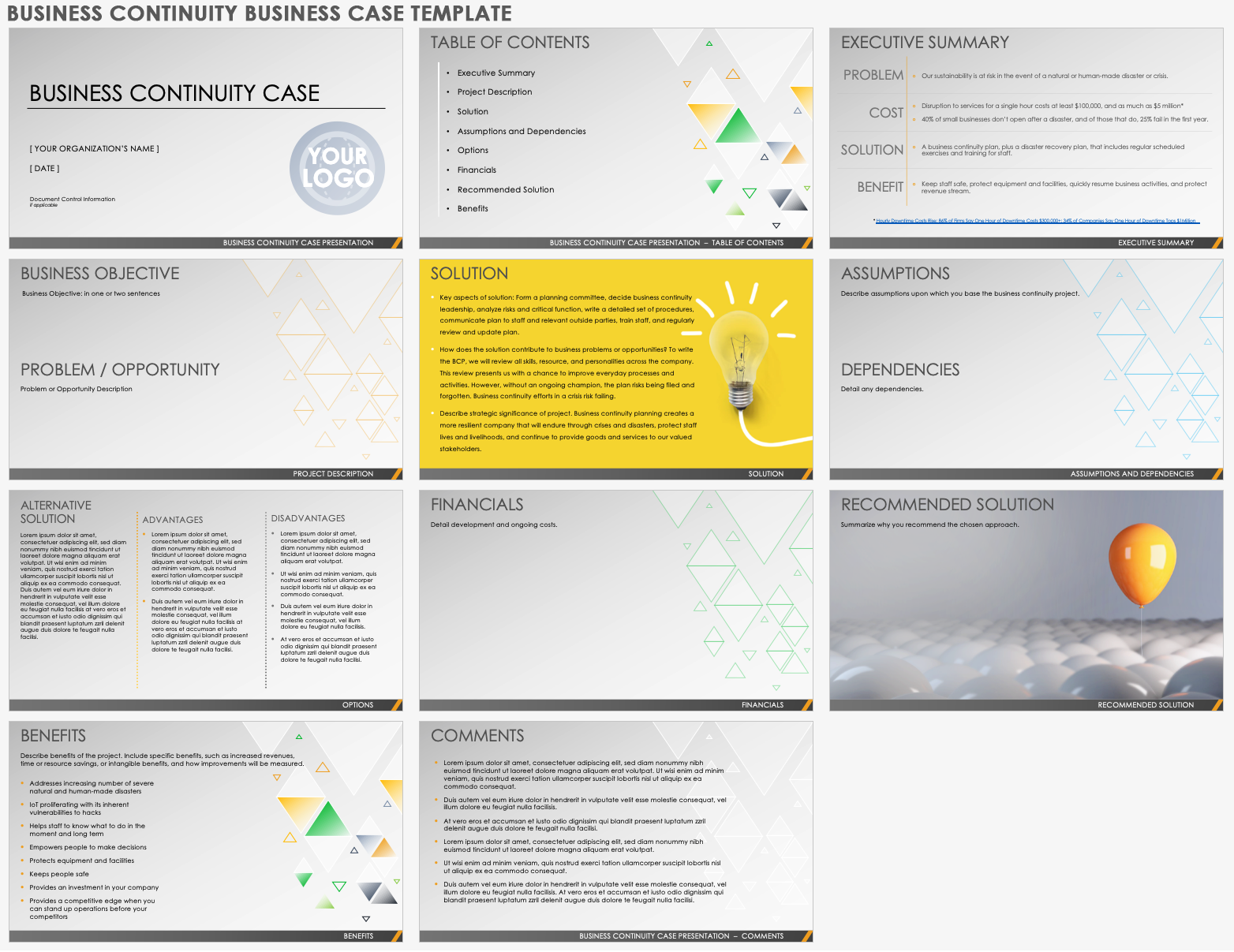What Is a Business Continuity Plan?
A business continuity plan (BCP) is part of a business continuity management system (BCMS), and includes the procedures an organization must follow in an emergency. The document also contains steps for recovery in the days and months after the incident.
One part of a BCP is the disaster recovery plan, which contains plans for IT and technical continuity. An organization can follow specific steps to write its business continuity plan, or hire an outside consultant. For details on writing a BCP, read "How to Write a Business Continuity Plan”,
Importance of a Business Continuity Plan
A strong business continuity plan can reduce risks during a crisis, and helps ensure that the company can continue to provide goods or services and earn income by detailing how to respond during and after an incident.
An often-quoted statistic claims that 40 percent of businesses never recover from a disaster. Although some experts question the statistic’s sources, it stands to reason that recovering from a major disruption is tough. After all, staying in business can be difficult, even during the best of times.
As business continuity consultant Alex Fullick, General Manager at Stone Road, explains, "I think the global pandemic has proven that everybody and every organization, no matter what size, needs the ability to respond and recover from any sort of eventuality, whether large or small. If anyone still has the mindset that it's going to happen to someone else, they're probably going to go out of business."
As natural disasters and data breaches become more frequent, the question is not if, but when a disruptive event will take place.
Business continuity plans can help an organization address the following issues before disruption occurs:
- People Don't Know What to Do in a Disaster: Proactively creating plans and training employees ensures a safe and timely recovery. When you've identified sensitive and critical functions ahead of time, you can better plan to execute quickly when a crisis occurs.
- Insurance Isn't a Solution: An organization may acquire insurance plans for healthcare, vehicles, or fixtures and equipment replacement. However, insurance can't cover the loss of customers who turn to other companies when you can't fulfill orders or reimburse you for a lost reputation.
- Creating a Plan Is an Investment in Your Company: Although a BCP may carry fixed costs in training, wages, or equipment, the plan will get your company up and running ASAP in a disaster. For more about budgeting for a business continuity plan, read “Business Continuity Planning: How to Do It Well.”
Business continuity can also provide a competitive edge. As the following examples show, companies that pursue business continuity are first to get back to work after a disaster.
- Fire swept through the facilities of Cantey Technology, a consultancy and server host, destroying cables and hardware. However, a business continuity plan gave the company the foresight to implement a redundant offsite data center with regularly scheduled backups, which ensured seamless, continued service for clients.
- In another instance of a fire, this time at a telecom provider, redundant network infrastructure and solid incident planning enabled the company to restore service within six hours of a fire reaching the switching center.
- Even though they were located on the second floor, Houston-based Gaille Media’s offices were destroyed during Hurricane Harvey. Since they stored their data and critical documents in the cloud, however, they continued to serve customers throughout the disruption, with staff working remotely.
"I find myself a little frustrated with some planners who have said, ‘Oh, they're busy updating their pandemic plan now,’" Fullick adds. "What do you mean you're updating your plan on people's availability? Don't you already have plans in place for, let's say, the winter flu season when you're missing 20 percent of your staff because they're all at home with the flu?"
How Business Continuity Helps Different Departments
| Functional Area | How Business Continuity Helps |
|---|---|
| Customer service | Ensure that you adhere to service level agreements (SLAs) even during disruptive events. Having a plan boosts your reputation with B2C customers, which is particularly important for health, food, and medical products. |
| Marketing | Preplanning and using the right marketing channels helps you quickly reassure customers and stakeholders, no matter the disruption. |
| Finance | A culture of integrated planning and rolling forecasts provide a global, real-time view of the company situation. Having a current picture will help you to quickly adapt to changes. |
| Human Resources | List the assets that you’ve assigned to each employee — doing so makes it easier to understand everyone’s capacity, once they work remotely. |
| Operations | Provide facility information and accurate floor plans to local emergency services to help expedite rescues. |
Importance of Business Continuity for the Supply Chain
Supply chain disruptions can be crippling, and a BCP can help sustain inventory levels. A business impact analysis (BIA) can reveal risks to key vendors’ ability to make and deliver goods in a crisis, so you can plan ahead.
Toyota plants in North America demonstrate how a broken supply chain shut down production thousands of miles away. After the 2011 Fukushima earthquake in Japan, Japanese parts manufacturers went offline. When Toyota plants in southern Ontario couldn’t get parts for the assembly line, the company had to lay off many employees.
"Companies are starting to realize they can be impacted, [and] not just directly by an upstream supplier that sends them something. That supplier can be impacted, too, and the effect trickles down,” Fullick explains. “[As] you see in the news, companies are starting to think more locally, rather than internationally. Companies have more control over a supplier or a vendor who is local, in the same state or province or country, than [they do] over a supplier in another country."
Ask how your suppliers will respond to a disruption to determine if they have a business continuity plan. Then, work that information into your BCP.
Importance of Business Continuity to Small Business
Small business owners often think they are exempt from crises — but when large-scale events occur, they can be among the first casualties. Almost a quarter of companies that do reopen fail within a year; having a BCP is essential to recovery.
"Unfortunately, some people think it won't happen to us," says Fullick. "That carefree attitude is no longer tenable, especially after a pandemic that affected everyone."
For Tony Bombacino, business continuity is a daily practice. He is the co-founder and President of Real Food Blends, a private company that makes whole foods for people with feeding tubes. “I'm always thinking to myself, 'What am I not thinking about?'” he says. “I spend a lot of time thinking about what might happen, and how to be ready for it.”
Bombacino also believes that business continuity preparedness starts outside of the business continuity plan. "It starts up front with contract negotiation” he says. “Cash is king in a small business.”
Real Food Blends doesn’t produce or pack their products, so it’s important that his manufacturing partners are large, stable, and have their own well-defined business continuity plans. If his partners aren’t prepared for handling disruption, his business might not be able to survive.
Importance of Business Continuity to IT
Most companies rely on IT to maintain services like the internet and Voice over IP (VoIP). The team also stores documents and runs machines. Without IT, a business is unworkable. Therefore, a business continuity plan for IT is crucial.
Importance of Business Continuity Planning in Crisis Management
Crisis management is part of a business continuity plan. Business continuity provides the overall approach for protecting human and other resources, and ensures that vital processes keep running. Crisis management focuses on communications and decision-making.
The Importance of Governance in Business Continuity Management
Effective governance is key to sustaining business continuity efforts. Governance starts with the business continuity policy, and the support of leadership ensures the plan always covers new risks.
However, not everyone thinks that governance always addresses all the correct questions. "Traditionally, governance tends to focus on how many scenarios your plan covers," explains Fullick. "It covers a flood, it covers fire, it covers an earthquake, a tornado, and a hurricane. You need a different plan for each one. Five plans. Each department has five plans, but do they contain the right detail?”
The Importance of Business Continuity to HR and People
Crises do not only impact tools and buildings — they also affect human well-being. If you understand how disasters change lives, you can better help staff manage their emotional and physical tolls.
"We bring our whole selves to work," says Debbie Rosemont, a productivity consultant and Certified Professional Organizer at Simply Placed, a business consulting firm. "I don't take my emotions, or what happened to me before I came to work, and set that outside. Who I am and how I feel shapes my ability to work and produce. When businesses or companies think about continuity plans, they've got to consider the whole person and how an event or disruption might impact somebody, even if it happens outside of work."
Disruptions can prevent people from coming to work. Illness, like a flu outbreak, may keep them at home. Damaged roads and train systems (that can occur after an earthquake) can hinder their commute. Whether employees commute to the office or work remotely, some of the following concerns may distract them from their duties:
- They fear they will be laid off.
- They've lost loved ones.
- They have a financial burden and are anxious about economic losses.
- They've suffered a disruption to their living arrangements with a loss of personal effects from a natural or human-made disaster.
"When there are job losses, when people don't know when they're going to get their next gig, when some people have lost numerous family members, this is extreme grief," says Michele Barry, Principal Consultant at Fortis Consulting. "You need your cloud system as your recovery system. You need an evacuation plan. You need to get all your files back after a crisis, which could motivate staff and sustain the business. But understanding people and politics is essential, too."
Rosemont suggests that doing business continuity planning in "normal times" is a chance for employers to source support systems. Employees can use these resources daily and during a crisis. Examples of resources include the following:
- An excellent healthcare benefits program
- An employee assistance program (EAP) that provides discounted legal or other advice
- Mental health and medical resources, such as access to doctors or counselors
- Daycare facilities or resources for both children and adults (such as elderly parents)
- Financial planning tools or advisors
- Sources of financial assistance
- Apps for meditation and calming anxiety
A further consideration, especially in natural disasters, is that it may be easier to restore the business than to gather your workforce. “It's easier to recover technology than it is to have the people there to use it,” explains Mike Semel, President and Chief Compliance Officer at Semel Consulting. “With the cloud and online backups, you can just go to somebody else's computer and log into Microsoft and get to your email. Your bigger problem will be people, and you need to focus on making sure your people don't disappear on you.”
In disasters, people may leave town. If you can keep people safe, but local, you may be able to recover your business faster. As an example, he shares how his company guided a credit union to contract with a local hotel chain. The executives would move their families to safety and only then return to work. This same consideration applies to small businesses. “If you're a doctor's office, you know that the doctor needs to be there,” says Semel. “The receptionist needs to be there. The nurse needs to be there.”
How Business Continuity Helps
| Industry | What Business Continuity Achieves | What Happens When You Don’t Have a Plan |
|---|---|---|
| IT | You are prepared for physical threats like floods and electronic threats like ransomware. | You could lose equipment and data, and risk fines for non-compliance. |
| Governance | You have a policy to guide a plan, and the support of top leadership to continually test and improve your skills. | Without strong governance, your organization risks not knowing what to do in a crisis. |
| Supply Chain | You have secondary sources for materials and backup manufacturers for your products in case you can’t meet customer demand. | Your production line could shut down and your customers could leave you. |
| Crisis Management | You have a plan behind your messaging to stakeholders. | You are communicating reassurances about business recovery without a clear approach to recovery. |
| HR and People | You have resources in place to help people and an empathy for their experiences. | You can’t offer support and may even be angry at employees if they miss work or their productivity declines. |
| Small Business | You arranged a line of credit so you can cover payroll when a snowstorm (or other disruption) reduces customers at your restaurant and revenue drops. | You have to let go of your wait staff. |
Business Continuity Business Case Template
Top leadership might wonder why they should invest time and money in business continuity planning. Use this free downloadable business case template to build a convincing argument for business continuity. These customizable slides include suggested argument points that you can adapt to fit your company’s needs.
Download Business Continuity Business Case Template — PowerPoint
For most useful free, downloadable business continuity plan (BCP) templates please read our "Free Business Continuity Plan Templates" article.
Benefits of Having a Business Continuity Plan
The benefit of a business continuity plan is that it prepares a company for a crisis. Trained staff will know what to do and the organization will be able to safely continue delivering key products and services, while meeting its legal and other commitments.
The following are additional advantages of business continuity:
- Review Weaknesses and Risks: Planning for business continuity provides valuable data and insights that have worth beyond emergency preparedness. Business continuity planning means leadership can assess skills, resources, strategies, and personalities, and uncover inefficiencies. Such findings often result from a business impact analysis. To learn more, read “All about Business Impact Analysis: A Step-by-Step How-To.”
- Understand Your Business Processes: Business continuity planning demands that you put your entire organization under a microscope. As a result, you can find and remedy inefficiencies in everyday operations, which will make your company more resilient.
- Improve Processes: Ideally, your plan will cover all aspects of the company and can reveal new challenges and opportunities. Improving processes at all levels pays for the investment.
- Help Companies Pivot Quickly: Planning helps you quickly recover critical IT systems and other processes after an incident.
- Build Confidence among Customers: With your BCP, customers know they can rely on continued access to your products or services. For example, when experiencing the aftermath of a natural disaster or a pandemic, B2C customers may find comfort in such things as a favorite food that you may provide. Your parts and services may help B2B customers pursue their livelihoods in the face of uncertainty.
- Build Confidence among Employees: A plan and adequate training shows staff what to do when a crisis occurs. They also have some reassurance that their jobs will continue during and after a disruption.
- Mitigate Financial Risk: A 2019 ITIC survey indicates that an hour of downtime can cost anywhere between $1 million and $5 million for large enterprises. Smaller businesses (those with 200 to 500 employees) responded that halting processes for one hour can cost at least $100,000. Can your company afford such losses? Plans reduce losses.
- Keep Your Team Members Safe: Creating and training staff on an accident response and evacuation plan can keep your team safe during accidents and disasters.
- Define Responsibility: When management and the chain of command grow ad hoc, they can fail in a crisis. A strong business continuity system names and trains crisis response leaders, and also provides roles for the rest of the team. "People need to be empowered to actually take action, and not sit there and wait for the CEO to make a decision," insists Fullick.
- Streamline Technology: As part of the process, you will review processes and the digital platforms and infrastructure that the company has pieced together over time. You may find that it’s practical to integrate technology, and one platform may effectively complete the tasks of several disparate apps.
- Allocate Key Financial and Human Resources: Understanding your company’s critical functions means you can focus financial and human resources on those processes, so you can keep the business running during a severe disruption.
- Provide a Way to Continue Working: Planning helps ensure that remote workers have access to the files, applications, and digital resources they need. This step reduces or eliminates downtime, so you can still provide products and services to customers.
- Eliminate Potential Costs: When a business is offline or closed, it inevitably loses revenue. However, slipped supply deadlines can result in additional fees from vendors or, depending on the locale and industry, fines for regulatory non-compliance.
- Make Coping in a Crisis Easier: In an emergency, people are often distracted thinking about their safety, as well as that of their friends and family. Training and a plan to fall back on helps people focus.
What Is Business Continuity Management (BCM)?
Business continuity management is the process a company uses to identify risks and, from there, to avoid or reduce the impact of those risks. Ultimately, this makes a company more resilient in a crisis.
Disruptive events can impact information systems, business processes, or both. For example, a hurricane or an earthquake can cut electricity. Without power to run data centers or laptops, business processes such as supply replenishment and payroll are impossible.
As StoneRoad’s Fullick explains, "Business continuity management is a set of plans and procedures to help you prepare for, respond to, and recover from business interruptions. Beyond that, it empowers people to make decisions when things occur. It's about knowing what resources and skills are available when something happens, whether it’s a small incident or a global pandemic."
With BCM, companies review their needs and capabilities to create contingency plans. From there, they can deliver at least some of their regular output, or the minimum acceptable service, in the event of a crisis. Continuity of service preserves a corporation’s reputation and revenue.
Benefits of Business Continuity Management System (BCMS)
A BCMS keeps staff safe and protects assets from risk. With human, IT, and other resources, a company can continue to provide goods and services. As a result, the company will continue to create revenue and retain a solid reputation.
You can learn about the types of risks and threats to organizations, as well as regulatory requirements for business continuity planning in our article, “Business Continuity Planning: How to Do It Well.”
"I don't think as many business people consider business continuity like they should,” says Bombacino. “I feel more prepared here, at my company, than I did when I worked at big companies. I think that’s because when big companies get really big or successful, or have lots of money, they think nothing bad can happen to them. One boss used to say there's a difference between being successful because of something and being successful in spite of something. Many companies are successful and don't have a business continuity plan. But what one thing could happen and wipe them out because they're not ready?”
Fullick adds that the value of business continuity will become increasingly clear to companies in the near future. “I think business continuity will grow as a key component for a lot of organizations, and [that] leadership on all levels is going to focus on BCP now.”
Disadvantages of Business Continuity Plans
Business continuity plans are costly and time-consuming to execute. Plans often require outside advice, and poorly written plans (or those that leadership doesn’t support) can be unsafe and cause financial losses.
A plan also risks becoming a ticked box on a requirements list, rather than an actionable, practical document. Management can forget to share the plan with the teams who could benefit from it. "Often when people aren't a part of discussions, the crisis management team is activated, but everyone else, including leadership, is sitting around and thinking, ‘What's going on?’” explains Fullick. “Management and employees are each waiting for the other to act. But people should know what to do and just start doing it."
Plan writers also often worry too much about specific disaster scenarios. "You need to focus on people, places, and things, and not so much on the trigger," Fullick urges. "You could lose your building because of a pandemic, or a flood, a fire, or an earthquake. Those are all different triggers for the same problem: What do we do now that our building is gone? Continuity planning should be about building a skillset, so your employees and leadership — beyond the disaster recovery team — know exactly what to do, and what the resources are, no matter what is happening."
In essence, business continuity planning empowers people and adds value to the company. Real Food Blends’ Bombacino says, “Some entrepreneurs hate meetings and process and structure. They don't want to talk about business continuity planning. But for us, this is our life's work. Other families, our customers, depend on us. So we view business continuity planning not as just a smart thing to do, but as our responsibility to make sure that we avoid the continuity pitfalls out there."
Improve Business Continuity with Real-Time Work Management in Smartsheet
Empower your people to go above and beyond with a flexible platform designed to match the needs of your team — and adapt as those needs change.
The Smartsheet platform makes it easy to plan, capture, manage, and report on work from anywhere, helping your team be more effective and get more done. Report on key metrics and get real-time visibility into work as it happens with roll-up reports, dashboards, and automated workflows built to keep your team connected and informed.
When teams have clarity into the work getting done, there’s no telling how much more they can accomplish in the same amount of time. Try Smartsheet for free, today.





